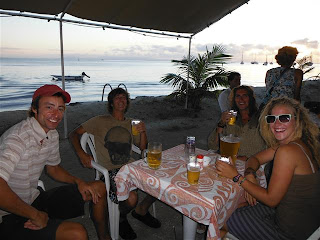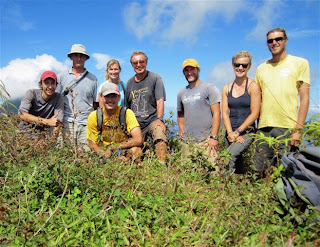I approached Bora with a few
preconceived notions that should have been erased by my experiences
elsewhere in Polynesia, but that I allowed to sour my expectations of
the island. I envisioned nothing but recently-married couples and
wealthy couples eager to re-live the recently-married days. I
envisioned them dense in the streets kicking up dust, shuffling about
rapidly, waving pocketbooks, a cacophony drowning the sound of the
waves with an anonymous, never-ending murmur. I imagined that it
would brutally change the way of these South Pacific islands, whose
way I had come to so embrace. I wasn't the only sailor with these
heretical thoughts (what did Bora do to deserve our judgement?) and I
wasn't the only sailor to sit happily in the lagoon with his foot in
his mouth.
True, there are a lot of hotels for
such a small island. The lagoon, though, is large and most of the
resorts primarily consist of slews of over-water bungalows that
branch over the shallows from motus or, occasionally, the main
island. They're really not very intrusive, and the visitors tend to
spend most of their time hanging around their bungalows, as opposed
to madly flocking the streets influencing everything around them with
heavy-hand and brutish indifference. On arriving on shore, it looks
and feels much like the other islands. There are more touristy shops
and the higher rate of visitors does dull a bit the openness of the
locals, but it retains the Polynesian charm and the people are as
wonderful as those of any place. Even when the honeymooners and
vacationers are out in force, everyone seems to have adopted well to
the island vibe. In short, I was wrong; I had a lot more fun than
expected. Bora is beautiful and tourists maybe aren't so bad.
When I first arrived, I spent three
nights on a mooring ball outside of the main town of Vaitape. Gypsy
Blues, Beau Soleil, Lay Lady Lay and a few other yachtie friends were
around, so there were plenty of mates with whom to explore the
island. The day after I arrived, Yohan, from Lay Lady Lay, and I hitch-hiked down the road to where Beau
Soleil had anchored and met up with Falcon. The three of us swam
across the lagoon to the fore-reef with the intention of harvesting
some snails for dinner, but the swell was too big in the end. A
Tahitian couple gave us a ride to shore in their skiff after they had
finished harvesting Tridacna
clams. On the way across the lagoon they offered us some of the plate
of those colorful lips (mantles, really, not lips) attached to bits
of white flesh. I ate a bit of a purple fellow. It had a strange
texture, slightly tough but with a celery crunch, and a mild taste. I
think a bit of coconut milk, some onion and lime would make it quite
nice, though I don't plan to make a habit of eating the beautiful and
very slow-growing creatures.
The next day, Falcon and I climbed the
two large peaks with Brian and Terry of Off Tempo; on the way up the
steep slope, as we stopped to admire the view, we met a few sailors,
Shannon and Alex from a Canadian cat called Ruby Soho and chatted
post-Bora plans for a bit. It was a fortuitous encounter, for I would
be on a similar track as Ruby Soho and they had a boat of five
awesome young people. We made it to the peak after one more steep
section with some handy ropes placed. Then, Falcon, who was doing the
hike barefoot, insisted that he and I attempt to break the record,
which had been set at 15 minutes by him and Yohan a few says prior,
for getting across the ridge between the two peaks. Reluctantly, I
started the chronograph on my wristwatch and took off after him down
the narrow trail, hurdling rocks and ducking branches and jumping
over logs. I almost launched myself off of cliffs two or three times
trying to keep up with Falcon, but we set the record at eight
minutes. The view was pretty good, too.
On the way down, since we didn't have a
whole lot to do that day anyway, we sat in the woods enjoying a sort
of flight of coconuts. We drank coconut water from the younger
specimens. From the slightly older, more yellow coconuts, we munched
some of the meat that would be ideal for baking or pressing to make
coconut milk. Then, from a sprouted coconut, which were abundant on
the floor of this slope, we ate uuuu (pronounced oo-oo, though there
is debate on the true Tahitian word), the substance left in the
coconut as a two to three foot stem struggles upward and little roots
seek a new water source. It's like coconut-flavored styrofoam in a
good way. The texture is strange, and the flavor ranges depending on
how large of a sprout you've got, but it's pretty tasty. Finally,
from the base of the sprout itself, in the middle of the stem, a
small bit of heart-of-palm can be harvested. It's a good treat.
Coconuts are useful.
It was Falcon's birthday that day, so
his parents brought Beau Soleil back around to Vaitape and a glorious
cruiser-birthday party was had, complete with rum drinks and singing.
The collection of gifts from fellow cruisers was comical and
endearing to our mutual plight: a bottle of nutella, a jar of
pomplemousse jam, a number of second-hand books. His parents were
prepared, of course, and gave him a beautiful new paddle for his va'a
(the outrigger canoe he bought in the Marquesas, which I had capsized
three times in my first twenty minutes of paddling back in Huahine).
It was another grande time, but I needed to get off of the mooring
ball and see some of this lagoon.
The next day, I went around the island
and anchored in the clear, sandy shallows off of Motu Taurere. There
were other boats around, but none I knew and I was feeling the desire
for solitude, so I spent the next couple of days alone, swimming,
enjoying the beach and taking it easy. I could have stayed longer
there, but I decided to go back to Vaitape, as it was Friday and I
needed to get to the Gendarmerie. It felt irksome and a touch too
momentous, but the time had come to check out of French Polynesia. I
made plans to leave early Monday morning for Maupiti, only 30 miles
west. Back in Vaitape, I anchored in 70 feet of water near Gypsy
Blues, friends from Toronto, and Birka, new friends from Sweden. I
went to the police station and checked out. It took about four
minutes to become, once again, a nowhere man.
Back at the boat, the voice of Nick on
Saltbreaker crackled through calling Ardea on the vhf. They were
coming in from Raiatea the same afternoon with boat from Vancouver,
Istupu. A party was soon in the making. Ruby Soho, a 48 foot
catamaran, was the only one able to host the the Swedes, Henrick and
Christine, Matt from Gypsy Blues, Nick and Alex on Saltbreaker,
Istupu and Ardea. Already with five residing on Ruby Soho, Alex,
Shannon, Adie, Dan and Jen, we had a solid crew and we made a
concerted effort to finish the last of Saltbreaker's jerry-jug rum.
To this end, we sat about the aft saloon laughing and passing round
the gasoline can, taking pulls of the plasticy sun-aged Flor de Cana
and sharing stories. It was a great time, once again a reunion amid
fresh faces, the cruiser community growing still, even after three
months on the circuit in Polynesia. I had perhaps one pull too many
on the old jerry jug, as I would learn the next day that when I left
I (allegedly) untied Saltbreaker's dinghy as well as my own. Nobody
noticed but Henrick and Christine returned not long after they left
towing the little fellow, who had been slowly drifing towards shore.
Naturally, I've denied all charges, though there appears to be no
other explanation possible, unless, on that very calm and windless
night, the knot itself slipped free, needing not the hand of a
drunken sailor. We may never know the truth.
Against all odds, Ruby Soho pulled the
hook early the next morning and left for Maupiti. It was Saturday. I
spent a few more nights expending my internet quota, taking
provisions and arranging the boat for the longer passages to come. On
Sunday evening, I very slowly hauled the more than two-hundred feet
of chain on board and joined Birka at anchor in the shallows of the
small motu just south of the pass.
I pulled the hook and departed with the
first light that Monday morning. I motored out the pass and put up
full canvas. It blew ten or twelve knots and I set about my day,
doing chores, reading, chatting with an hf radio net as Esmeralda
steered a fine course and Ardea made five and a half knots for
Maupiti. By 1230 I was motoring into the narrow pass, pitching with a
large swell and trying to keep a course maintaining the alignment of
the approach markers on shore as dolphins made acrobats of themselves
in the breakers on both sides of the channel. They were very
distracting, but, as long as one uses both sets of approach markers,
the pass to Maupiti was not nearly so terrible as some had thought
back in Bora. I anchored near the motu by Ruby Soho and Birka. I
rested a bit after the passage before pumping up the dink and
moseying on over to the “cleaning station.”
I tied the dinghy up to a little
mooring ball and put on my fins. I jumped in with my mask on and was
immediately greeted, to my surprise, by a gigantic manta ray.
Evidently, the harmless plankton-feeders come to this spot near the
pass with lots of current and sort of bask as their gills are cleaned
of parasites by little symbiotic fish. Most say the morning is the
best time to see them, but I figured I might as well check it out in
the afternoon, not really expecting much. But I ended up swimming
with two of the magnificent beasts. It was an otherworldly
experience. Their wingspans were more than ten feet and they moved
with breathtaking grace. I managed to get only a few poor photos
before my waterproof camera began letting water in again, but it was
an amazing introduction to Maupiti.
I got back to Ardea and found myself
after dinner hanging with the Swedes and thinking how this place
seemed to have good things in store. Soon more friends would arrive
and we had a big, beautiful lagoon and white sandy beaches. It felt
good to have finally made that symbolic leap from Bora and we all
smiled knowingly, somehow feeling that this island was a particularly
good one.

























































